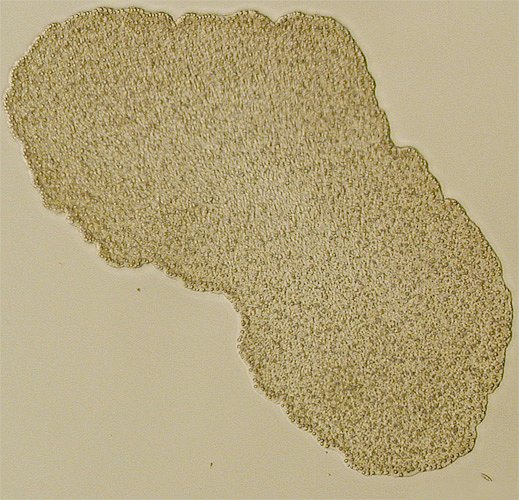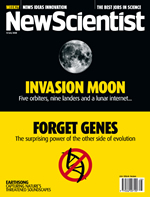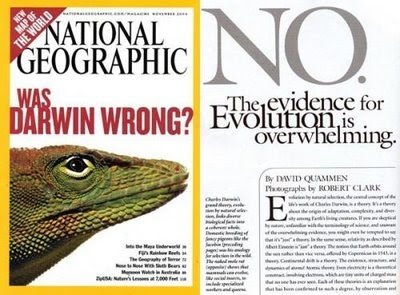Today’s Quirks and Quarks on CBC was about Darwin — with David Quammen, Steve Jones, and Olivia Judson — hear here.
Category Archives: Media
Forbes on Darwin.
Well, I certainly don’t agree with their full selection of authors (see Pharyngula and NeuroLogica), but anyway here is the set of papers in Forbes on evolution.
Surveying a landscape of cognition–and controversy.
We fail to realize just how much evolution shapes our personalities.
Charles Darwin knew about romance.
Keeping Pace With Change
Why it matters that behaviors evolve.
Survival Of The (Financially) Fittest
Evolutionary pressures and economic fate.
Fear of a Darwinian, animalistic hedonism is unfounded.
Why Evolution Doesn’t Matter
Forget century-old debates. Biology should inspire technology for the future.
Slavery is hard to justify if all species–animal, black and white–share a common ancestor.
Glimpses of the earnest passions behind the beard.
The Debate Over Intelligent Design
What would Darwin say?
There Is No ‘Politically Correct’ Science
It’s impossible to isolate Darwinian theories from their societal consequences.
Did Alfred Russel Wallace think up evolution first?
Lies, Damned Lies, and Science…
I just received an email about the release of this new book
Lies, Damned Lies, and Science: How to Sort through the Noise around Global Warming, the Latest Health Claims, and Other Scientific Controversies
by Sherry Seethaler
Here is the overview:
Are antioxidants good or bad for you? Is global warming real – and if so, why it is happening? Do scientists really now think that sun exposure prevents cancer? Is organic food healthier? Do antidepressants trigger suicides? Every day, the media is packed with stories about health and science: stories that can sometimes mean the difference between life and death. Which of these stories really matter? Non-scientists desperately need tools for telling the difference between real science and misleading science.
Lies, Damned Lies, and Science: How to Sort through the Noise around Global Warming, the Latest Health Claims, and Other Scientific Controversies (FT Press Science, ISBN-13: 9780137155224, $24.99, 224 pps, hardcover, February 2009) www.ftpress.com/science helps readers sort out today’s noisiest scientific debates — and gives them common-sense techniques for evaluating any health or scientific claim. Sherry Seethaler, a science writer and educator at University of California, San Diego, works with scientists to explain their discoveries to the public. Seethaler holds an M.S. and Master of Philosophy in biology from Yale, and a Ph.D. in science and math education from UC Berkeley.
Seethaler says, “Those who promote incorrect information, either because they are trying to manipulate you, or because they themselves have been duped or are simply misinformed, rarely have more knowledge about science than you do. What they have are skills at using information to suit their purposes.â€
This could be very good, or very not-good. Anyone read it?
The accurate language challenge, part III
Here’s one from the latest issue of The Scientist (emphasis added!).
Two hundred years after the birth of Charles Darwin, scientists are exploring one of the central questions of evolution: When organisms become more complex, by adopting the fittest traits for their environment, do those traits place constraints on further evolution? In other words, can complexity slow down the process of evolutionary change? ANDREA GAWRYLEWSKI visits scientists performing an ambitious experiment – involving at least 4,000 mice in the last several years alone – as they set out to find an answer.
The accurate language challenge, part I.
Here is a little exercise I use in my evolution class. I post a segment of a news story that describes an evolutionary process in sloppy terms and then ask the students to translate it into language that accurately describes what is going on.
Here’s one from today’s Discovery News.
Lizards Evolved Quickly to Avoid Death by Ants
It takes some effort for fire ants to get under the hard scales of an unsuspecting lizard. When the insects finally penetrate the reptile’s fleshy core, the attackers inject a toxin that paralyzes their victim. Then, they tear the lizard to pieces, which they carry back to their nest.
…
It’s an unpleasant way to die, and one that at least one species of lizard is rapidly evolving to avoid. In just 70 years, according to a new study, eastern fence lizards in parts of the United States have developed longer hind limbs and new behaviors that help them escape the clutches of the venomous ants.
Have at it!
(Hint: Start your answer with “Within a population of lizards…”)
________________________
Get your Darwin Year gear here.
Worse than lower and basal.
Why can’t reports in the media accurately convey the basics of evolution? And why can’t scientists make a dedicated effort to clarify things whenever they give an interview? What hope is there for clarifying the most fundamental concepts when every story seems to reinforce misconceptions?
From the Discovery Channel:
Ancestor For All Animals Identified
A sperm-looking creature called monosiga is the closest living surrogate to the ancestor of all animals, according to new research that also determined animal evolution may not always follow a trajectory from simple to complex.
Yet another find of the study, published in the latest PLoS Biology, is that Earth may have given rise to two distinct groups of animals: bilaterians — animals with bilateral symmetry, like humans — and non-bilaterians, which include corals, jelly fish, hydra, unusual, often poisonous, creatures known as cubozoans, and other organisms.
Free-living, unicellular organisms called choanoflagellates, however, could be on every person’s family tree, so long as it was a gigantic one.
…
They determined that so-called “simple” and “lower” tier animals, such as corals and jellyfish, evolved in parallel to “higher” animals, like seemingly more complex insects and even humans. On the tree of life, monosiga then currently holds the root position for the latter group.
Please, let’s try to get this right from now on. No study reconstructing phylogenetic relationships between modern taxa tells you what the ancestor of those taxa was. It may provide some clues, but all species being examined are derived in some ways and primitive in others.
No biologist who knows anything about evolution would suggest that evolution “always follow[s] a trajectory from simple to complex”. There is no such thing as “higher” and “lower”, though this pre-evolutionary idea apparently is hard to abandon.
And not every rearrangement of proposed evolutionary relationships is a revolution. Many of the deep nodes have been enigmatic for a long time, so it’s not a surprise when they move around based on improved information. Here is how I, an evolutionary biologist, react to each new molecular phylogeny that moves animal branches around:
“Neat. I wonder if it will hold up. It will be interesting to think about what this means in terms of major patterns.”
For a much better take on this new phylogeny written by someone with expertise, see Todd Oakley’s latest post. If we could just get more scientists to write blogs…
(Incidentally, the idea that the ancestors of animals were choanoflagellate-like organisms dates to the 19th century. I even parodied this well-known idea on a shirt).
________________________
Get your Darwin Year gear here.
Lower and basal.
The story:
New Tree Of Life Divides All Lower Metazoans From Higher Animals, Molecular Research Confirms
The response:
“It is absurd to talk of one animal being higher than another” (Charles Darwin, 1837)
More information:
Understanding evolutionary trees
(By the way, Rob DeSalle, who is quoted in the story, was one of my postdoc advisors and he definitely understands phylogenies — but the story is pretty sloppy nonetheless)
New Scientist takes the hype road.
The primary goal of a magazine is to sell magazines. However, if a magazine is about science and wishes to preserve its credibility as a source of science information (and thus, to sell magazines), it should do its best to avoid unnecessary hype, especially when this touches on sensitive issues in science policy or education.
Well, I am afraid to say that New Scientist, which I have previously praised for excellent, balanced coverage [here and here], now looks to be taking the hype road.
Look at these two recent cover stories.
Forget genes? Really? This story was about epigenetics, and floated the idea that maybe evolution is Lamarckian after all. Nevermind the fact that they don’t seem to know what Lamarckian evolution actually is.
This one has, rightly, provoked the ire of many bloggers/scientists [see here, here, here, here, here, here, here, here, and here]. It is without question irresponsible, poorly timed, and sure to be invoked by anti-evolutionists, making the job of defending science and science education more difficult. The explanation offered by the author/editor for it is unacceptable.
Fundamentally, Darwin was right about his two big ideas that really matter: common descent and natural selection. To say “Darwin was wrong”, even within the article’s context, is nonsense. The fact that it will undoubtedly be taken to refer to the big ideas rather than a specific analogy makes it infuriatingly misleading.
Compare this with the approach taken by National Geographic.
Pretty provocative cover, but still phrased as a question — and answered without ambiguity.
There is a lot that Darwin didn’t know, and I hope that the success of evolutionary biology in the 150 years since the Origin is talked about in abundance this year. But the fact that his two big ideas, common descent and natural selection, have survived every scientific discovery since the mid 1800s is overwhelmingly convincing that he was brilliant and insightful and right. (The associated story, Modern Darwins by Matt Ridley, is certainly worth reading.)
To be clear, I don’t think magazines should make decisions about their covers or articles solely on the basis of how anti-evolutionists might use them. But as communicators, they — and any scientists interviewed in popular articles — have a responsiblity to think about the implications of what they say.
As pointed out recently by Scott and Branch,
in science, we do not shape our research because of what creationists claim about our subject matter. But when we are in the classroom or otherwise dealing with the public understanding of science, it is entirely appropriate to consider whether what we say may be misunderstood.
I strongly encourage New Scientist to rethink the message that cover stories like this send.
And New Scientist drops a notch.
What’s wrong with you, New Scientist?
And you’re not off the hook either, scientists.
“We have no evidence at all that the tree of life is a reality,” says Bapteste.
Sigh.
This one is just too annoying and overstated to discuss. See Evolutionary Novelties, Sandwalk, and Evolutionblog instead.
This week’s paradigm shift: a single-celled organism can also leave tracks.

My displeasure with media stories continues today with another over-the-top, speculative, and tailor-made-for-quote-mining article from Discovery News. The gist of it is that some people saw a very large, single-celled organism leaving tracks in the sand. Therefore, we need to “revolutionize” the way we think about evolution because maybe this is the sort of creature that left trace fossils in the Cambrian.
The choice bits:
Single-Celled Giant Upends Early Evolution
Slowly rolling across the ocean floor, a humble single-celled creature is poised to revolutionize our understanding of how complex life evolved on Earth.
…
The finding could overturn conventional thinking on a mysterious time in the evolution of early life known as the Cambrian Explosion. Until about 550 million years ago, there were very few animals leaving trails behind. Then, within ten million years an unprecedented blossoming of life swarmed across the planet, filling every niche with hard-bodied, complex creatures.
“It wasn’t a gradual development of complexity,” Matz said. “Instead these things suddenly seemed to burst out of a magic box.”






